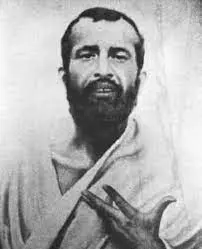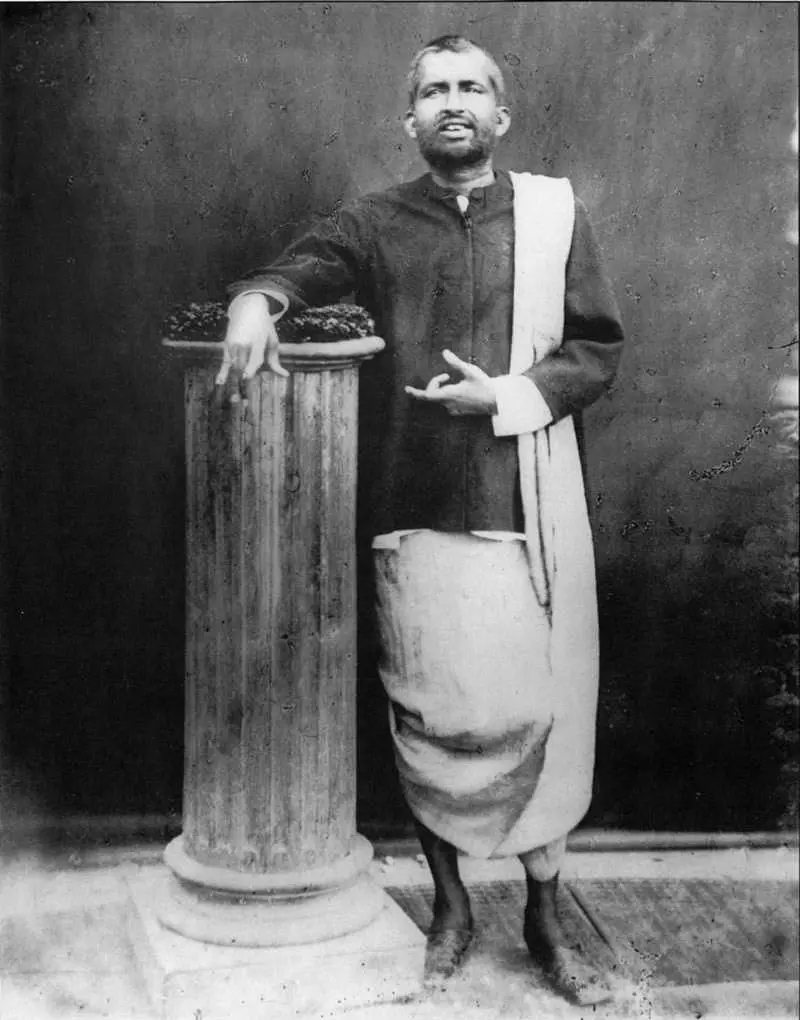 Ramakrishna Paramahansa was a great 19th century Hindu mystic. Born 1836 in Kamarpukar, Bengal, he passed over in Dakshineshwara in 1886. Ramakrishna’s personal experience revealed to him the unity of all spiritual paths.
Ramakrishna Paramahansa was a great 19th century Hindu mystic. Born 1836 in Kamarpukar, Bengal, he passed over in Dakshineshwara in 1886. Ramakrishna’s personal experience revealed to him the unity of all spiritual paths.
When his brother died the following year, Ramakrishna took his place. His devotion to the goddess made him long passionately to see a vision of her. He was in such despair that he was on the brink of suicide when finally, Kali showed herself to him, and he dedicated the rest of his life to her. At the age of 23, his family forced him into marriage: in a trance, Ramakrishna picked out a little five-year-old girl, whom he married five years later, but with whom he lived in a state of perfect chastity.
Initiated by a tantric ascetic who saw in him a divine reincarnation, Ramakrishna achieved perfect union with God; a second guru taught him the Vedanta which enabled him to reach a state of fusion with the Brahman, in which he remained for six months, and which he was able to re-enter at will during the more or less continuous ecstasy he experienced afterwards. At a later date, when he was studying with a Muslim and then a Christian, Ramakrishna had the experience of Allah, and the experience of Jesus. Soon he had followers of his own, attracted to him because of his radiant joy, his gentleness and his humility. By his very presence, he facilitated entry to their inner divine dimension. The disciples stayed together after his death, worshipping his widow who lived until 1920.
Practice of Other Religions
Sri Ramakrishna realized that the infinite reality is comprehensible and realisable in countless ways and through infinite paths. He became possessed of deep longing to realise God through other religions, following meticulously their particular traditions and modes of worship. This is one unique characteristic that distinguishes Sri Ramakrishna from ordinary spiritual aspirants and perhaps even other saints: whereas they practised disciplines of one tradition and achieved their goal through them, Sri Ramakrishna practised with insatiable gusto the disciplines of different cults and religions, the entire vast-ranging gamut of the various cults of the Hindu religion, as well as some other major religions of the world.
He began his spiritual journey as a humble image worshipper in the Kali temple at Dakshineshwara; passed on to the tantra mode of worship of Sakti or Power, attaining siddhi (acme of attainment) through a rich variety of traditionally known sixty-four tantric methods of sadhana under the guidance of his woman-guru Bhairavi Brahmani; thence to the various bhavas (spiritual attitudes or moods) known to Hinduism, namely, thinking of oneself as the mother and God as the Divine Child (called Vatsalya Bhava), oneself as the humble eternal servant and God as the Divine Master (Dasya Bhava), oneself as the bride and God as the Divine Bridegroom (Madhura Bhava); finally culminating in the realization of the ultimate truth as the impersonal absolute, formless, nameless, attributeless (Advaita Vedanta) under the guidance of Tota Puri. Even this did not satisfy his divine hunger. Like a glutton in the spiritual realm, Sri Ramakrishna began to explore other religions. He meticulously went through the practices of Christianity and then Islam, attaining the acme of realization in each of them.
He is unparalleled in the spiritual and religious history of humanity as having undertaken the practice of the various religions as an insider—becoming a Christian, a Muslim, and so on and realizing God through each of them, establishing that each of these religions was a valid and true path to attain the supreme reality. He enunciated one of the most liberal religious doctrines of the modern age:
‘The Ultimate Reality is Infinite and the paths leading to It are also infinite.’
Sri Ramakrishna’s significant legacy is the Ramakrishna Order of monks working through the twin organizations Ramakrishna Math and Ramakrishna Mission for atmano moksartham jagaddhitaya ca (Sanskrit), that is, “for the liberation of oneself and for the good of the world,” established by Swami Vivekananda in 1897 at the command that he received from Sri Ramakrishna before the latter passed away. These twin organizations have been working in the East and the West since their inception for the all-round welfare of the whole world—physical, mental, intellectual, moral, aesthetic, and spiritual—irrespective of caste, creed, religion, and nationality, preaching the gospel of universal harmony and peace.
Philosophy of Harmony –
Essential Teachings of Sri Ramakrishna
The teachings of Sri Ramakrishna, based as they are on his profound spiritual realizations were summarised by his chief disciple, Swami Vivekananda.
Freely rendered, these teachings are:
- Religion is realization, direct and immediate, of the ultimate reality or truth, which is personal-impersonal. This realization is the essence of true spirituality. To acquire this first and become a dynamo of spirituality is the greatest service we can do to humanity.
- The ideal of harmony is pre-eminent and paramount — harmony of all religious paths as equally valid paths to the ultimate reality. This leads naturally to universal acceptance, not mere toleration.
- Various religions of the world are but manifestations of one eternal religion of God. Truth may be One and many at the same time, that we may have different visions of the same Truth from different stand-points. Therefore the watchwords are help and not fight, integration and not destruction, harmony and peace and not dissension.
- The Many and the One are the same Reality, perceived by the same mind at different times and in different attitudes.
- Every soul is divine. However, this divinity is not recognised. The Goal is to manifest this Divinity within by controlling Nature, external and internal and attain Freedom by any path: this is the whole of religion; doctrines or dogmas, rituals or temples, books or forms are but secondary details.
Interfaith Mentor?
Sri Ramakrishna’s unmistakable contribution lies in the field known nowadays as theology of religions. The scope and meaning of interfaith engagement are a function of implicit and explicit views of other religions. “The experience lived by Sri Ramakrishna and his articulation of its philosophical and theological meaning are therefore foundational to the approach of his followers to interreligious relations. It is the key to their openness and to their interest in engaging other religions.
More significantly, Sri Ramakrishna suggests a special approach to relations across religions, one that is often overlooked and one that is sorely lacking in the broader interfaith arena. His is not the activist’s quest for peace-making or social reform. His is the quest for God, and God alone. Crossing over to other religions is part of a spiritual quest, a yearning for tasting God in his infinite expanse and wealth. Sri Ramakrishna therefore not only provides the philosophical and theoretical foundations for interfaith engagement; he holds out a vision of what the highest form of interfaith engagement looks like. It is an encounter of the great spiritual Masters, who seek to enrich each other in the process of tasting and experiencing divine reality.

Image Credit: Wikimedia Commons, Wikimedia Commons
![]()

